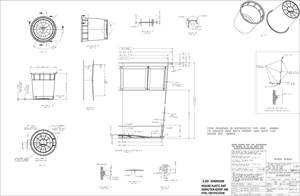Delcam (Salt Lake City, UT) has launched the 2012 version of its FeatureCAM feature-based CAM system, with a range of enhancements to enable faster and easier programming, and produce more efficient toolpaths to give greater machine productivity. All these developments will ensure that FeatureCAM retains the leadership in programming speed and ease of use it has held since its launch in 1995, when it was the world’s first feature-based programming system. Full details, including videos demonstrating the new functionality, can be seen on www.delcam.tv/fc2012/lz.
A number of the improvements will make FeatureCAM even easier to use. For example, a range of keyboard shortcuts have been added, including isometric view options, which will allow faster programming. It has been made easier to select multiple items from the operations tree and to move all the features in a group, for example, a network of similar holes or all the operations on a particular spindle. In addition, warning or error messages can be displayed simply by hovering over the relevant icon in the Operations List.
Toolpath editing has also been made much easier. Toolpaths are displayed more clearly, selection of toolpaths has been simplified and an “undo” option added.
Target part comparison has been extended to cover multi-axis operation for both milling and mill-turn equipment. This allows the user to compare a model of the desired final shape with the shape achieved by the programmed toolpaths. It provides a quick check of any material remaining on the part, and of any gouges or collisions. Previously, this option was only available for 2- and 3-axis operations.
Two new strategies are available—back boring and spiral roughing. Back boring allows more parts to be completed in a single set-up, with larger bores able to be produced on the reverse side of the part. Spiral roughing can be used instead of Z-level roughing. It uses a single continuous toolpath instead of a series of levels and so gives a smoother finish with no dwell marks.
The most important improvement for increasing machine productivity comes from further developments in the use of stock models to cover 2D features, including bosses, sides and slots. The models allow the user to visualize the stock remaining after each operation. This makes it easier to eliminate air cutting and so generate more efficient toolpaths with reduced machining times. The models also simplify the selection of the most appropriate tool sizes for rest-roughing and finishing operations.
A number of extra options have been added to the tooling database. This database is a key part of the automation in FeatureCAM as it allows the optimum operating conditions to be associated with each tool. In most companies, the database is developed by the most experienced user. It then ensures that even inexperienced operators use safe and efficient cutting parameters. The new options in FeatureCAM 2012 allow more variables to be specified, including maximum cut depth and the optimum ramp angles.
Fully-automated de-burring and chamfering, when programming 2- or 2.5-axis parts, were added in FeatureCAM 2011. Tool selection for these operations has now been improved, to avoid unnecessary tool changes.
Other improvements include a new option to automatically counterbore holes before drilling, the ability to have a negative leave allowance (such as a fitting allowance) for turning or wire EDM to produce undersized features without remodelling, and much improved performance on the largest part files with hundreds of thousands of entities.
delcam.com
Related Content
Products and Services for Multiple Moldmaking Needs
New year, new technology roundup! Featured here is a collection of product offerings, from profile milling cutters to industry-specific CAD/CAM software to innovative hot work tool steels.
Read MoreMold Design Review: The Complete Checklist
Gerardo (Jerry) Miranda III, former global tooling manager for Oakley sunglasses, reshares his complete mold design checklist, an essential part of the product time and cost-to-market process.
Read MoreWhat is Scientific Maintenance? Part 2
Part two of this three-part series explains specific data that toolrooms must collect, analyze and use to truly advance to a scientific maintenance culture where you can measure real data and drive decisions.
Read MoreIt Starts With the Part: A Plastic Part Checklist Ensures Good Mold Design
All successful mold build projects start with examining the part to be molded to ensure it is moldable and will meet the customers' production objectives.
Read MoreRead Next
Reasons to Use Fiber Lasers for Mold Cleaning
Fiber lasers offer a simplicity, speed, control and portability, minimizing mold cleaning risks.
Read MoreHow to Use Strategic Planning Tools, Data to Manage the Human Side of Business
Q&A with Marion Wells, MMT EAB member and founder of Human Asset Management.
Read MoreHow to Use Continuing Education to Remain Competitive in Moldmaking
Continued training helps moldmakers make tooling decisions and properly use the latest cutting tool to efficiently machine high-quality molds.
Read More











_300x250 4.png;maxWidth=300;quality=90)




.jpg;maxWidth=300;quality=90)








